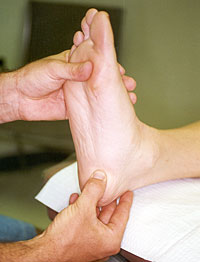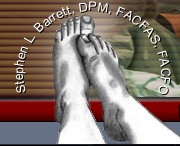 What
is Heel Spur Syndrome / Plantar Fasciitis? What
is Heel Spur Syndrome / Plantar Fasciitis?
It is often described as a "stone bruise" by the patient. Pain is
usually worse in the morning, especially with the first several
steps, or after periods of rest when first standing. As the pain
worsens, the heel can hurt even while not weight-bearing.
What causes it?
Heel Spur Syndrome, or heel pain, is usually caused by a mechanical
problem involving the structural alignment of the foot. There is a
dense fibrous band of tissue in the bottom of the foot known as the
plantar fascia. The plantar fascia inserts into the heel bone and
spreads out into the foot (see diagram). Because of mechanical
misalignment of the foot, excessive tension is placed on this band
of tissue, causing inflammation and pain. The size or presence of a
heel spur does not always correlate with the amount of pain.
Maybe it will just go away.
This is possible, in some patients. However, this is not usually the
case. In most cases the longer the patient waits to seek treatment,
the more chronic the condition usually becomes, and thus requires a
more lengthy and involved treatment.
Does the heel spur have to be removed?
No! It has been clearly demonstrated in the medical literature, as
well as clinically in thousands of patients, that an inferior heel
spur is a secondary effect, and not the source of the heel pain.
Even when the condition has to be addressed surgically, in most
cases nothing is done to the spur. What needs to be treated is the
inflammation near the spur, where the plantar fascia connects to the
heel bone.
How should the condition be treated?
In the vast majority of cases, usually greater than 70% of the time,
a patient with this condition can successfully be treated
conservatively - without surgery! Treatment can include many
different modalities based on individual cases. But before surgery
is contemplated, thorough conservative care should be exhausted.
|



